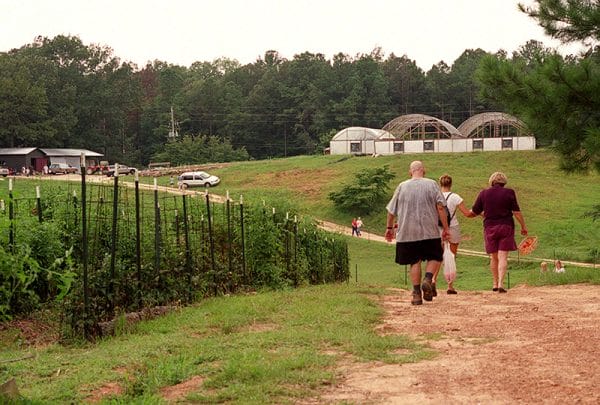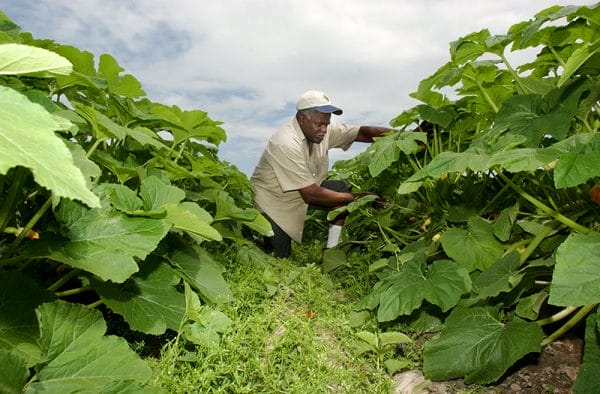Organic Farming
Organic farming is poised to become an emerging industry in Alabama as public concerns about health and the environment increase. A number of small-scale organic farms have been established around the state that emphasize the use of compost and manure to nourish the soil, crop rotation to avoid nutrient depletion and reduce pest infestation, and the avoidance of synthetic fertilizers and pesticides. New direct-marketing opportunities, such as farmers markets, community-supported agriculture, marketing networks, and online resources, have spurred this effort to provide Alabama consumers with organically produced foods.
 Farmer’s Market
Interest in organic production began in the United States in the 1960s and 1970s, amid rising concerns about the effects of agricultural chemicals on human health and the environment. These concerns led to a desire for farm products raised without synthetic chemicals, and in response proponents worked to establish farming systems that became known as “organic.” Production methods were defined and refined over the following decades as organic products improved in quality, and demand for them has been on the rise ever since. Alabama’s oldest organic farms were established in the 1980s, but the broader adoption of organic farming practices in the state lagged behind other parts of the country. Skepticism and lack of widely available information about the effectiveness of organic farming methods, lack of consumer demand, and the challenging climate all played roles. For the most part, conventional producers and traditional agricultural educators were not eager to adopt organic practices and doubted that they would work in Alabama.
Farmer’s Market
Interest in organic production began in the United States in the 1960s and 1970s, amid rising concerns about the effects of agricultural chemicals on human health and the environment. These concerns led to a desire for farm products raised without synthetic chemicals, and in response proponents worked to establish farming systems that became known as “organic.” Production methods were defined and refined over the following decades as organic products improved in quality, and demand for them has been on the rise ever since. Alabama’s oldest organic farms were established in the 1980s, but the broader adoption of organic farming practices in the state lagged behind other parts of the country. Skepticism and lack of widely available information about the effectiveness of organic farming methods, lack of consumer demand, and the challenging climate all played roles. For the most part, conventional producers and traditional agricultural educators were not eager to adopt organic practices and doubted that they would work in Alabama.
Organic production is especially challenging in the hot, humid South. The long growing season benefits pests at least as much as it does food crops. The North’s long, cold winters kill pests that survive in the Southeast, and the dry heat of the Southwest constrains disease pressure there. Although soil types vary throughout the state, soil fertility and organic-matter content are generally low, due in part to the hot climate, which allows organic matter to be broken down more rapidly than in cooler regions, and intensive commercial agriculture, which has depleted many soil nutrients. Decayed plant and animal matter in the soil helps to hold moisture and nutrients in place and is a key component in organic soil building. The availability of products such as organic pesticides, fertilizers, and feeds has also been limited because of high transportation costs for these products from other parts of the country, thus adding to the difficulties for Alabama farmers trying to adopt these practices.
 Grow Alabama
Despite these challenges, the interest in organic production in Alabama has grown significantly since the 1990s. As of 2015, approximately 35 farms and 10 food handlers in Alabama were certified organic or certified with an alternative label from Certified Naturally Grown, Inc., a nonprofit group whose certification is based on USDA organic standards. Many more use organic practices but are either exempt from certification or elect to use other words to describe their practices. This growth has been paralleled by more marketing opportunities that allow farmers to retain a greater portion of the retail price. Producer-only farmers markets, community-supported agriculture, online sales, and group marketing efforts have all increased markedly in the past few years and allow farmers to sell directly to their customers. Because of this approach, most of Alabama’s organic farms are producing vegetables, small fruits, cut flowers, and herbs intensively on fewer acres. There is also increasing interest in organic meat, especially grass-fed beef. In addition, Auburn University and Alabama A&M University have established organic research facilities, and the number of educational opportunities for farmers interested in organic production has expanded significantly. As the amount of research and organic farming experience in Alabama increases, most likely the number and size of organic farms in the state will rise as well. Despite these developments, however, few Alabama producers of traditional commodity crops, such as cotton, peanuts, corn, and soybeans, have adopted organic practices.
Grow Alabama
Despite these challenges, the interest in organic production in Alabama has grown significantly since the 1990s. As of 2015, approximately 35 farms and 10 food handlers in Alabama were certified organic or certified with an alternative label from Certified Naturally Grown, Inc., a nonprofit group whose certification is based on USDA organic standards. Many more use organic practices but are either exempt from certification or elect to use other words to describe their practices. This growth has been paralleled by more marketing opportunities that allow farmers to retain a greater portion of the retail price. Producer-only farmers markets, community-supported agriculture, online sales, and group marketing efforts have all increased markedly in the past few years and allow farmers to sell directly to their customers. Because of this approach, most of Alabama’s organic farms are producing vegetables, small fruits, cut flowers, and herbs intensively on fewer acres. There is also increasing interest in organic meat, especially grass-fed beef. In addition, Auburn University and Alabama A&M University have established organic research facilities, and the number of educational opportunities for farmers interested in organic production has expanded significantly. As the amount of research and organic farming experience in Alabama increases, most likely the number and size of organic farms in the state will rise as well. Despite these developments, however, few Alabama producers of traditional commodity crops, such as cotton, peanuts, corn, and soybeans, have adopted organic practices.
In order to create a uniform set of standards for what can be labeled organic, Congress passed the 1990 Organic Foods Production Act (Food Agricultural Conservation and Trade Act of 1990, Public Law 101-624). This legislation led to the creation of the National Organic Program and the development of the National Organic Standards, which were implemented in 2002 and are overseen by the National Organic Standards Board (NOSB). The standards outline the specific requirements for organic production, with input from a board made up of a spectrum of farmers, processors, retailers, scientists, public-interest advocates, and environmentalists. The standards prohibit the use of genetically modified organisms and synthetically produced fertilizers and pesticides and also regulate the use of nonsynthetic inputs. In addition, the Organic Materials Review Institute (OMRI), a national nonprofit agency, reviews agricultural inputs and categorizes their use for organic agriculture. These guidelines and monitoring agencies have created a more uniform system of organic certification in the United States. Alabama farmers that choose organic certification now follow these federal guidelines and can be certified by one of many agencies based around the country.
 Mt. Laurel Organic Farm
Organic production is much more than a list of approved inputs, however. Scientists and researchers at the NOSB define organic agriculture as an ecological management system that focuses on developing healthy soil and plants and developing systems to control pests based on ecological principles and cultural practices, which many conventional farmers employ as well. On organic farms, soil fertility is enhanced with animal manure, compost, cover crops, and some approved fertilizers such as lime, rock phosphate, and greensand (a potash-rich material made up partially of fossilized marine animals). Crop rotation also is an essential part of organic farming, and it involves the division of total farmland into smaller plots. Farmers systematically alternate different types of crops, including cash and cover crops, among their fields in a pattern that ideally repeats after a set number of years. The system helps to interrupt pest life cycles and avoids the nutrient depletions that are common in soils on which the same crop, such as cotton, is grown over and over. Pests are also managed by encouraging populations of parasitic and predatory insects, planting at times that avoid peak pest seasons, using physical barriers such as floating row cover, a material that allows sunlight and rain to reach plants while keeping insects out, and spraying with approved pesticides if necessary. Disease is managed in part by selecting varieties that have been bred for resistance to certain diseases, managing moisture levels with trellising or plant spacing, and managing insects that carry disease, such as thrips and aphids. Weeds are managed using mulches, using no-till methods, plowing or cultivating fields, hand weeding, and even controlled burning with gas torches. In addition to providing organic feed, organic livestock health is managed by encouraging healthy living conditions and limiting stress. Livestock medications are subject to review and cannot be used on a routine basis.
Mt. Laurel Organic Farm
Organic production is much more than a list of approved inputs, however. Scientists and researchers at the NOSB define organic agriculture as an ecological management system that focuses on developing healthy soil and plants and developing systems to control pests based on ecological principles and cultural practices, which many conventional farmers employ as well. On organic farms, soil fertility is enhanced with animal manure, compost, cover crops, and some approved fertilizers such as lime, rock phosphate, and greensand (a potash-rich material made up partially of fossilized marine animals). Crop rotation also is an essential part of organic farming, and it involves the division of total farmland into smaller plots. Farmers systematically alternate different types of crops, including cash and cover crops, among their fields in a pattern that ideally repeats after a set number of years. The system helps to interrupt pest life cycles and avoids the nutrient depletions that are common in soils on which the same crop, such as cotton, is grown over and over. Pests are also managed by encouraging populations of parasitic and predatory insects, planting at times that avoid peak pest seasons, using physical barriers such as floating row cover, a material that allows sunlight and rain to reach plants while keeping insects out, and spraying with approved pesticides if necessary. Disease is managed in part by selecting varieties that have been bred for resistance to certain diseases, managing moisture levels with trellising or plant spacing, and managing insects that carry disease, such as thrips and aphids. Weeds are managed using mulches, using no-till methods, plowing or cultivating fields, hand weeding, and even controlled burning with gas torches. In addition to providing organic feed, organic livestock health is managed by encouraging healthy living conditions and limiting stress. Livestock medications are subject to review and cannot be used on a routine basis.
Many of Alabama’s new organic farmers are returning to family land after a period off the farm. Some grew up on farms, but others have little agricultural experience. Farmers include retirees, professionals who have decided to pursue a new career, and young people just out of high school or college. Many traditional farmers also are transitioning from conventional production. Alabama’s organic farmers may differ in age, race, region, and level of experience, but they all share a passion for growing organically and making their farms work.
 Organic Farm in Shorter
Many of these farmers grow a wide variety of crops that go beyond the standard summer vegetables: gourmet lettuces, salad mixes, and other greens, heirloom tomato varieties, root crops such as beets, carrots, radishes and turnips, culinary and medicinal herbs, and cut flowers. Extending the season and types of crops allows the grower to market over a longer time period and provide a wider variety of produce. Some farmers are also raising livestock, including cattle, sheep, pigs, goats, and chickens, and are selecting and developing breeds that fare well in the South. Because most of these crops are marketed directly to the consumer, growers can teach their customers about new crops and breeds and encourage them to experiment.
Organic Farm in Shorter
Many of these farmers grow a wide variety of crops that go beyond the standard summer vegetables: gourmet lettuces, salad mixes, and other greens, heirloom tomato varieties, root crops such as beets, carrots, radishes and turnips, culinary and medicinal herbs, and cut flowers. Extending the season and types of crops allows the grower to market over a longer time period and provide a wider variety of produce. Some farmers are also raising livestock, including cattle, sheep, pigs, goats, and chickens, and are selecting and developing breeds that fare well in the South. Because most of these crops are marketed directly to the consumer, growers can teach their customers about new crops and breeds and encourage them to experiment.
Overall, organic systems rely on a diversified approach to soil improvement and pest management; they are subject to continuous experimentation and improvement. As organic farming gains popularity and support in Alabama, organic production improvements and innovations and additional farms will surely follow.
Further Reading
- Coleman, Eliot. The New Organic Grower: A Master’s Manual of Tools and Techniques for the Home and Market Gardener. White River Junction, Vt.: Chelsea Green, 1995.
- Duram, Leslie. Good Growing: Why Organic Farming Works. Lincoln: University of Nebraska Press, 2005.
- Lampkin, Nicholas. Organic Farming. Ipswich, U.K.: Old Pond Publishing, 2003.



